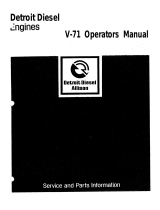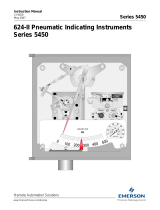Page is loading ...

OPERATION
When set for direct acting, a fall in steam pressure
(Fig. 1) at the controller lowers branchline pressure,
opening a normally open valve to maintain steam presure
at control point. When set for reverse acting, an increase
in pressure at the controller lowers branchline pressure,
opening a normally closed valve to maintain steam
presure at control point.
NT REQUIRED
-
Commercial cleaning solvent or degreaser.
-
Lubricant 3 10879.
-
Gage 305965 (O-30 psi).
-
Gage Adaptor MQP 729.
WARNING
arelesss
handlingof solvents can result in
permanent
damage to the respiratory system or skin. Avoid
prolonged inhalation of vapors or contact with the skin.
Visually inspect the controller for any indication of
external damage, broken or dented pressure input
lines, leaky
connections,
etc.
Remove the
controller
cover and brush all loose dust
and dirt from the case with a soft cloth or brush. Take
care to avoid brushing foreign
matter into the nozzle.
If there is caked grease present that cannot be brushed
away, remove by brushing t
e area with commercial
cleaning solvent,
4.
Coat all adjustment screw
reads
and pivot
points
with Lubricant 310879.
Check the levers for freedom of movement by varying
the setpoint of the
controller.
This is accomplished by
turning the
adjustment
knob located on the top of the
case. If the levers are operating freely,
e
controlled
device will move
throughbits full range of
Pressure changes in the br
installing a 0 to 30 psi ga
the
controlled
device.
If the operation of the device is erratic or restricted by
ed parts or bent levers, remove from service and
repair or replace (see REPAIR section).
1.
Check the changeover cink (Fig, 2) to determine if it
is in the position to give the desired action.
a.
When the lower end of the changeover link is
connected to the left-hand side of the main lever,
the controller will
e direct acting. In this
position, an increase in pressure on the bellows
bly increases control air pressure.
the lower end of the changeover link is
connected to the right-hand side of the main lever,
the controller is reverse acting. In this position, an
increase in pressure on the bellows assembly
reduces control air pressure.
. To change the link from one position to the other,
carefully spread the prongs on the lower end of the
link and place the link in the desired position.
4.
5.
e certain the supply air
the inlet side of the
ictor is at least 13 psi (90
emove the top of the changeover link from the
flapper
(Fig.
2),
and lift the flapper away from the
nozzle, The air should bleed down to 1.5 psi (10
kPa)
or less. Adjust the restriction if necessary,
hen control air pressure is reduced to its
minimum
pressure,
carefully replace the flapper over the nozzle.
Note the time required for air pressure to build to full
supply pressure. Lift the flapper and note the time
ired for air pressure to bleed down to 1.5 psi
(10
st the restrictor until the build-up and bleed down
time are
approximately
equal,
After the proper setting
been obtained, attach the
changeover link to the
fl
75-
1075
2

CONTROL POINT
THROTTLING RANGE
ADJUSTMENT SCREW
THROTTLING
CHANGEOVER RANGE SCALE
RANGE INDICATOR
THROTTLING RANGE
THROTTLING
ECCENTRIC SCREW
RANGE SPRIN
LEVER STOPS
PIVOT ADJUSTMENT
MAIN LEVER
--.-/
BELLOWS ASSEMBLY
Fig. 2.
PP97A
with Cover Removed.
CONTROL POINT
Turn the control point adjustment knob (Fig. 2) to the
desired pressure.
Setpoint
is read on the scale located on
the outside of the controller. The control point setting
establishes the low end of the throttling range,
THROTTLING
The throttling range adjustment determines the pressure
change necessary to cause the controller to vary the
control air pressure from 3 to 13 psi (21 to 90
kPa).
By
adjusting the throttling range, the sensitivity of the
controller can be changed to meet requirements.
Turn the throttling range adjustment screw (Fig. 2)
until the indicator on the throttling range scale is
opposite the desired setting. The throttling range scale is
graduated from the minimum setting (marked MIN), to
the maximum setting (marked F). The divisions between
the two extreme settings are marked A through E.
Because the throttling range of any one controller varies
with the setting of the adjustable restriction and the
setpoint
of the controller, no set value can be assigned to
the divisions of the throttling range scale.
Refer to Table 2 of the maximum and minimum
throttling range for each controller pressure range.
However, the setting for any specific throttling range will
have to be determined by operating the individual
con troller.
NOTE:
PP97A1035
(0 to 15 psi range) is equipped with
a stop placed on the throttling range setting at
D, which provides a maximum throttling range
of approximately 10 percent of the
setpoint
scale
range.
Table 2. Approximate Throttling Ranges of
PP97A.
0 to 15 psi
I
0.1 psi
1.5 psi
5 to 150 psi
6.5 psi
(69 to 2068
kPa)
(17
kPa)
(83
kPa)
CALIBRATION
Calibrate the
PP97A
after the restrictor is properly set
and, if possible, when pressure on the bellows is
approximately equal to the midpoint of the
setpoint
scale
of the controller.
Adjust the
setpoint
of the controller until the air
pressure in the branch line is 3 psi (21
kPa)
for a
direct acting controller, or 13 psi (90
kPa)
for a
reverse acting controller. At this setting the
indicator on the
setpoint
scale should indicate the
same pressure that is being applied to the bellows.
If the setting does not agree with the pressure on
the bellows, loosen the four screws holding the
setpoint
scaleplate. Adjust the
setpoint
scaleplate
until the
setpoint
indication and the pressure on the
bellows are equal to each other. Retighten the four
screws.
3
75-
1075

AND PERFORM
OPERATIONAL
CHECK.
I
HONEYWELL
-
Minneapolis Minnesota 55408
*
Scarborough, Ontario M1P 2V9
*
Subsidiaries and Affiliates Around the
World
0
Printed in U.S.A.
/

